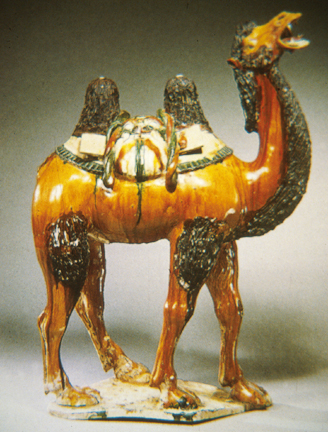
TANG DYNASTY BACTRIAN CAMEL, EARTHENWARE,
China, 618 -906 CE, 30" height
ART 198 - HISTORY OF WORLD CERAMICS
| The Tang Dynasty saw a rise in the use of lead glazing for earthenware tomb figures such as this Bactrian Camel. The big advantage of lead glazing is that lead is an excellent flux, which promotes complete glaze melting, resulting in bright clear glazes and brilliant colors. The Silk Road between China and the Middle East passed through Bactria, and the camels from this region were used to ferry good, people, and ultimately ideas back and forth. Lead was imported from Persia as were many ideas for form and surface design in ceramics. These camels were familiar sights along the route and came to be known as 'ships of the desert.' This beautiful example, made from a light earthenware clay, stands proud and bellows. This figure was painted with three colored glazes: a dark green, an amber, and a darker brown, the three colors developed during Han times. This type of glazing, utilizing three colors is called SANCAI glazing (SAN = three, CAI = color). These glazes, called lead silicate glazes, made by combining glass (silica) and flux (lead) are very runny and this effect can clearly be seen on this example. These burial figures also recall the army of Shihuang-di in their realism, but show the evolution of the style into an era of glazing. | TANG DYNASTY BACTRIAN CAMEL, EARTHENWARE, China, 618 -906 CE, 30" height |
|
|